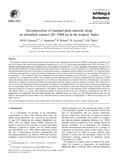Mostrar el registro sencillo del ítem
Decomposition of standard plant material along an altitudinal transect (65-3968 m) in the tropical Andes
| dc.rights.license | http://creativecommons.org/licenses/by-nc-sa/3.0/ve/ | |
| dc.contributor.author | Couteaux, M. | |
| dc.contributor.author | Sarmiento, Lina | |
| dc.contributor.author | Bottner, Pierre | |
| dc.contributor.author | Acevedo N., Dimas R. | |
| dc.contributor.author | Thiery, J. | |
| dc.date.accessioned | 2013-08-05T14:44:34Z | |
| dc.date.available | 2013-08-05T14:44:34Z | |
| dc.date.issued | 2002 | |
| dc.identifier.uri | http://www.saber.ula.ve/handle/123456789/37383 | |
| dc.description | Publicado en: Soil Biology and Biochemistry 34 (2002) 69-78 www.elsevier.com/locate/soilbio | |
| dc.description.abstract | The dynamics of plant decomposition in the soil were analysed in an altitudinal transect from 65 to 3968 m under tropical conditions. Six sites were studied, with a mean annual temperature ranging from 5.5 to 27.4°C, and an annual precipitation from 790 to 1992 mm. A 14C-labelled standard plant material was incubated in situ, at 5 cm depth, over a period of 1.5–3 years, depending on the altitude. The aim was to determine the contribution of climate (temperature and moisture) and of other factors, such as soil properties, to explaining the differences in mineralisation between the sites. Data analysis was performed using two-compartment models with first-order kinetics. To evaluate the effect of climate on decomposition, a response function to temperature (τ) and a response function to moisture (μ) were calculated. The kinetics of the remaining 14C were adjusted to the two-compartment first-order model considering successively time, τcum (cumulated τ), and τμcum (cumulated τμ) as independent variables. The assumption was that if the introduction of a climatic component into the explanatory variable reduces the distances between the decomposition curves of the sites, the differences are related to this factor. If the distance is not reduced, other factors in addition to climate must influence decomposition and/or the climatic response to altitude is not linear. The results show a clear decrease in decomposition with increasing altitude. Nevertheless, the altitudinal effect is not equal for the two fractions estimated using the two-compartment model. The size of the labile fraction decreased with altitude, whereas the recalcitrant fraction increased. The labile fraction decomposed very quickly, independently of the altitude, whereas the rate of decomposition of the recalcitrant fraction decreased with altitude. When τcum is used as the independent variable, the distance between the curves diminishes, indicating the great effect of temperature on decomposition, but in the high mountain sites, additional factors act. Using τμcum the difference between sites was not reduced, showing that the moisture effect is low or that the moisture response function is not appropriate. | |
| dc.language.iso | en | es_VE |
| dc.rights | info:eu-repo/semantics/openAccess | |
| dc.subject | Decomposition | |
| dc.subject | Soil organic matter | |
| dc.subject | Global change | |
| dc.subject | Carbon dynamics | |
| dc.subject | Climatic response function | |
| dc.title | Decomposition of standard plant material along an altitudinal transect (65-3968 m) in the tropical Andes | es_VE |
| dc.type | info:eu-repo/semantics/article | |
| dc.description.colacion | 69-78 | es_VE |
| dc.description.email | lsarmien@ula.ve | es_VE |
| dc.description.email | dimas@ula.ve | es_VE |
| dc.subject.tipo | Artículos | es_VE |
| dc.subject.unidadinv | Instituto de Ciencias Ambientales y Ecológicas (ICAE) | es_VE |
| dc.type.media | Texto | es_VE |
Ficheros en el ítem
Este ítem aparece en la(s) siguiente(s) colección(ones)
-
Articulos, Pre-prints (Facultad de Ciencias)
-
Articulos, Pre-prints (Instituto de Ciencias Ambientales y Ecológicas (ICAE))
Articulos, Pre-prints del Instituto de Ciencias Ambientales y Ecológicas (ICAE)


